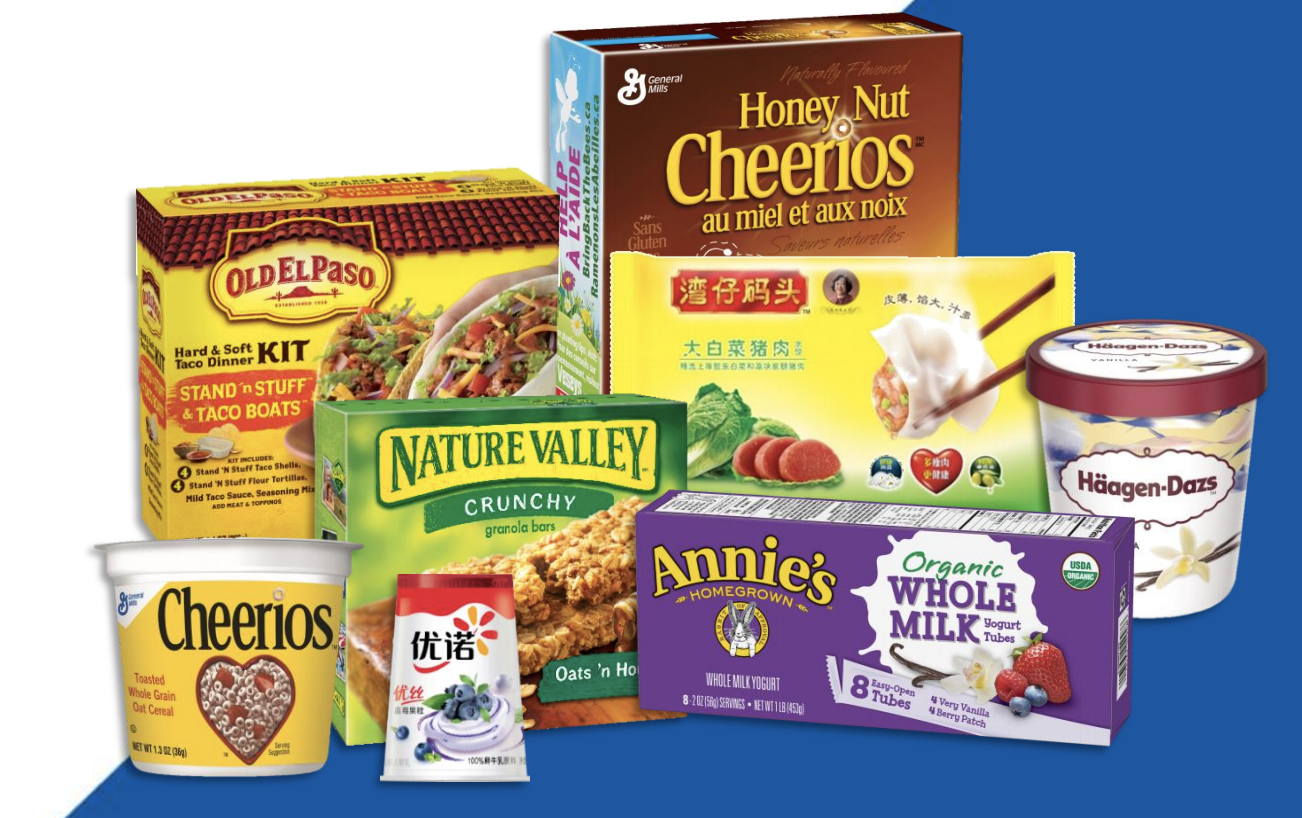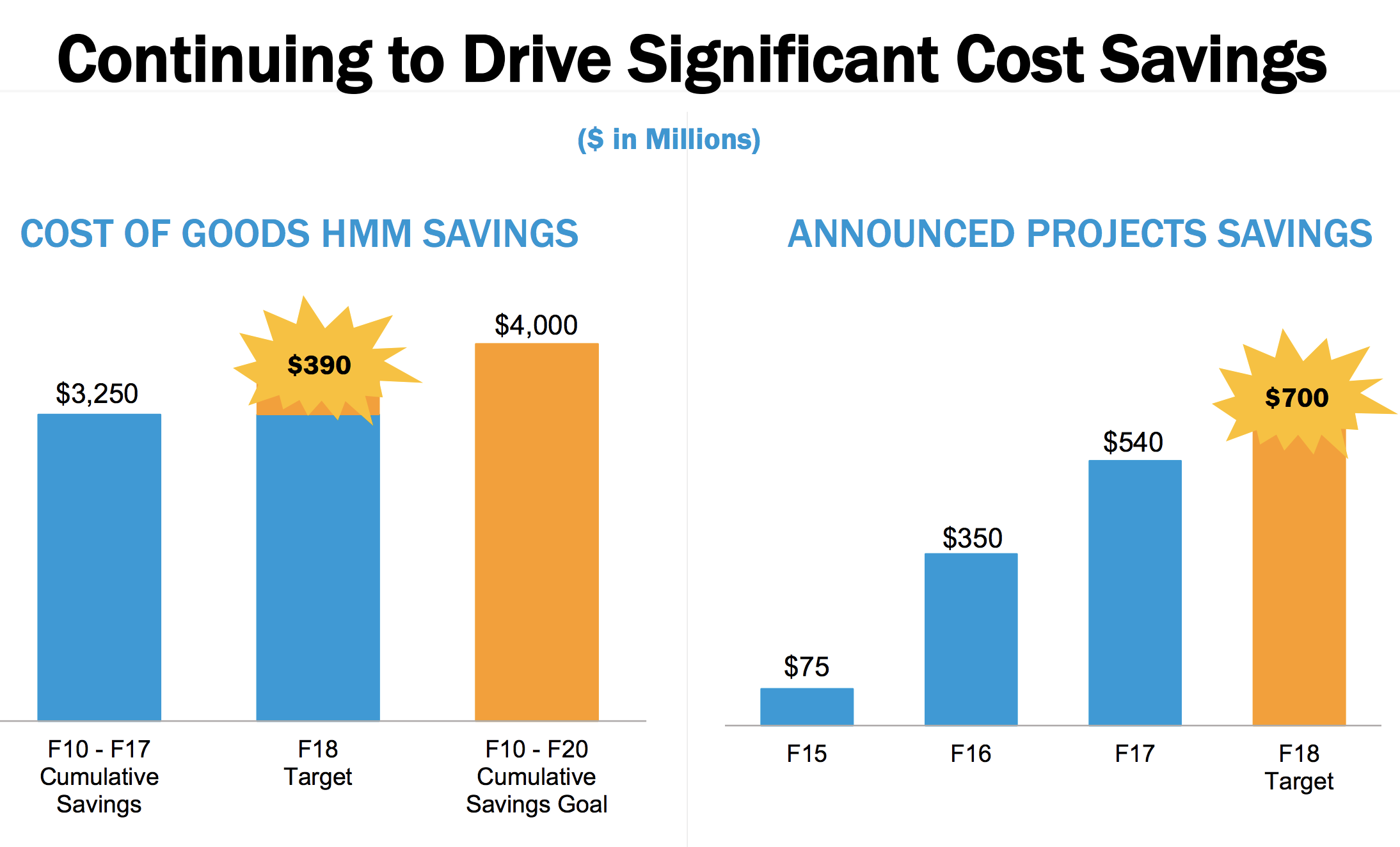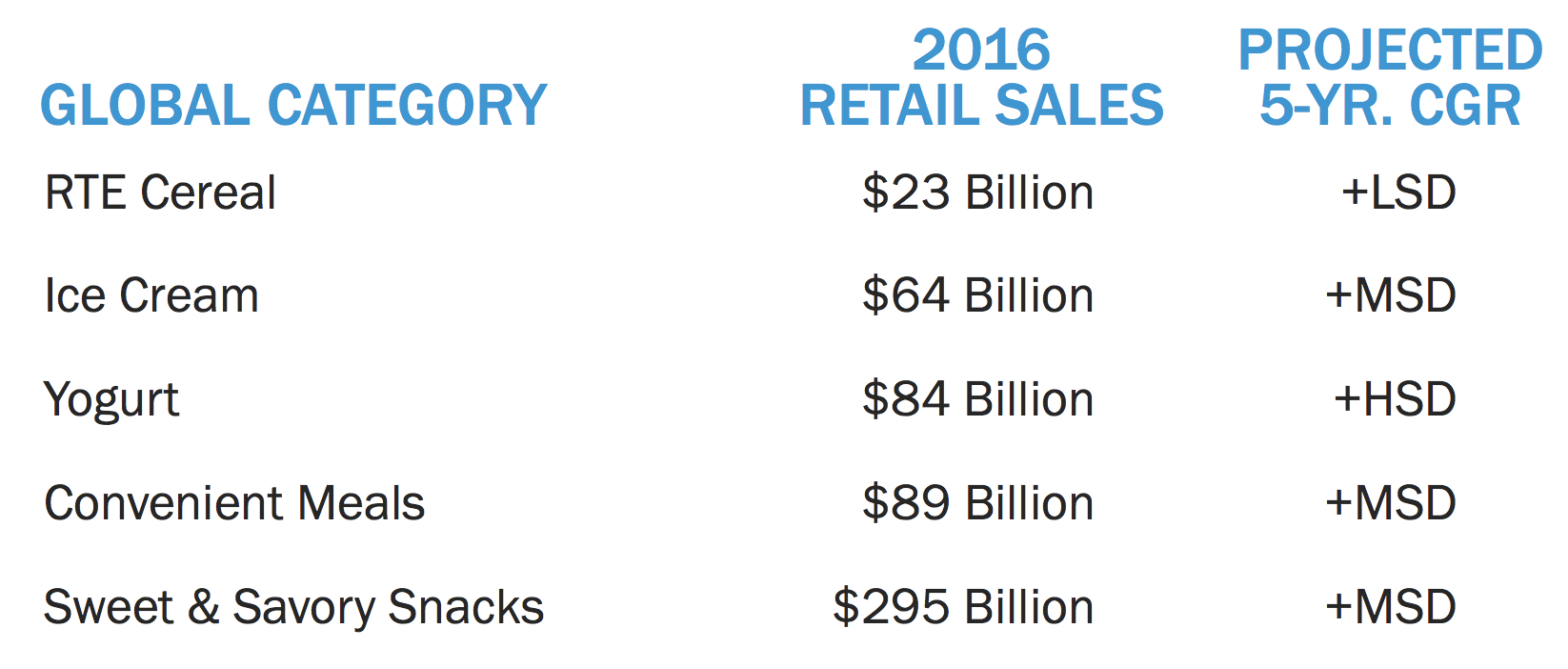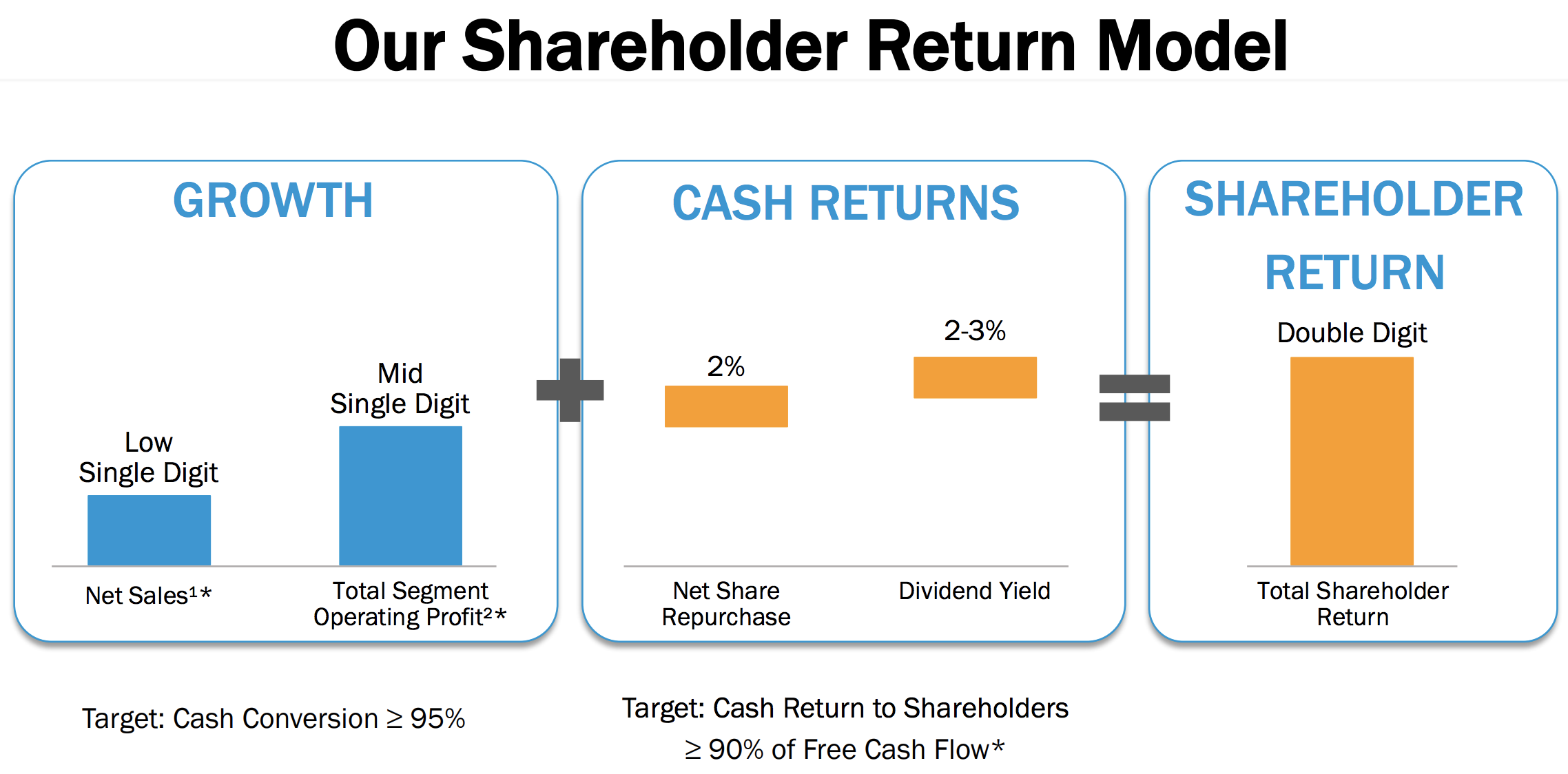General Mills went into business in 1866, owning just a single flour mill at the time. Since then, the company expanded into a number of different industries, including restaurants, toys, and even apparel. However, the business refocused completely on consumer foods in 1995.
Today, General Mills sells a diversified mix of packaged meals, cereal, snacks, baking products, yogurt, and more. The company’s largest brands are Cheerios, Betty Crocker, Yoplait, Pillsbury, Nature Valley, Old El Paso, and Haagen-Dazs. Each of these brands generates over $1 billion in annual sales.

While natural and organic food only accounted for 7% of the company’s total revenue in fiscal 2017, General Mills is one of the largest organic food manufacturers in the U.S. and seeks to increase the size of this business to $1.5 billion by fiscal 2020 (from $1.1 billion last year). Growth will be helped in part by continued expansion of its Annie’s brand (acquired in 2014) into new categories.
By product category, snacks accounted for 21% of sales last fiscal year, cereal 17%, convenient meals 17%, yogurt 15%, dough 11%, baking mixes 11%, ice cream 5%, and vegetables and other products 3%.
General Mills primarily sells its products to large retailers such as Wal-Mart (20% of sales), and over 70% of its sales last year were made in the U.S. The company has more than 600 SKUs per store and has been expanding its product categories organically and via acquisition.
The company’s divisions are below, and you can see that the bulk of its profits are from its North American operations.
North America Retail (65% of sales, 78% of profit): sells meals, cereals, snacks, baking products, and yogurt and other products to a number of grocery stores, mass merchandisers, dollar stores, natural food chains, and other retailers.
International (23% of sales, 8% of profit): consists of retail and foodservice business outside of the U.S. The product categories are mostly the same as the U.S. retail business. Europe and Australia account for just over half of revenue and around two-thirds of profits with Asia and Latin American generating the remainder.
Convenience Stores & Foodservice (12% of sales, 14% of profit): General Mills sells its products in this segment through many channels including foodservice, convenience stores, vending, and supermarket bakeries.
Business Analysis
General Mills and its predecessors have been around for more than 150 years. Compared to newer companies, General Mills benefits most from its scale, long-standing distribution relationships, entrenched brands, and decades of marketing spend. These advantages have enabled the company to pay uninterrupted dividends for more than 115 years.
With almost any consumer product, marketing and product innovation are keys to long-term success.
General Mills can outspend smaller players when it comes to marketing campaigns to ensure its products remain in the forefront of consumers’ minds. General Mills spent more than $620 million last year on advertising and media to protect the brand value of its products, and even higher spending is expected next year to revitalize growth.
In addition to customer loyalty, these investments help General Mills more easily pass on input cost increases during years of higher commodity prices.
When you start to add up the total dollars General Mills has invested in marketing over the last several decades, it becomes daunting to think about the challenge new food companies face in winning over consumers to their less familiar brands.
This spending has helped General Mills maintain strong market share positions. Most of the company’s brands hold the number one or number two share positions in their categories and have proven to be very resilient over the years.
In ready-to-eat cereal, General Mills has the second highest global market share and owns three of the top five U.S. brands. In refrigerated baked goods and grain snacks, market share positions are even higher at 70% and 40%, respectively.
Many of the company’s core brands have been on the shelves for decades. For example, Cheerios and Nature Valley were introduced in 1941 and 1975, respectively. General Mills’ retail customers also have little incentive to try out products from new competitors as long as the company’s products are selling well. According to Nielsen data, a whopping 85% of consumer packaged goods that launch in the U.S. today will fail within two years. It’s no surprise retailers are reluctant to displace mainstay brands.
Given the high failure rate of new products, General Mills’ existing portfolio of successful brands is even more valuable.
The company’s product diversification and financial strength allow it to maintain its lead and continue experimenting, too. Few companies have the luxury to invest over $215 million annually in R&D like General Mills has done in each of its last three fiscal years.
General Mills is also well diversified by product category, with snacks representing its biggest group at 21% of sales last year. As consumer trends unexpectedly change, General Mills is somewhat hedged by playing in so many different products. When one category changes directions and requires new R&D and marketing investment, another is likely playing to General Mills’ existing strengths.
While General Mills might be late to catch on to certain consumer trends, its product diversification, financial firepower, and distribution relationships help ensure that it can evolve to remain relevant for years to come. Introducing Greek yogurt and gluten-free cereals are two examples of recent trends General Mills is following.
The company’s massive size can cause strategic shifts to take longer to impact overall sales mix, however. In these instances, General Mills has not hesitated to acquire its way into faster-growing markets or divest declining businesses to sharpen its focus. The company sold its struggling Green Giant brand (frozen vegetables; 4% of total sales) for $765 million in 2015, and it meaningfully extended its reach in the natural and organics space with its $820 million acquisition of Annie’s in 2014.
With U.S. industry sales for natural and organic foods growing at a double-digit rate, it’s no surprise General Mills wants to continue growing its share in this category (General Mills is a leading natural and organic foods manufacturer with a 17-year operating history in the industry).
When General Mills acquires other product lines or develops new products, it also benefits compared to smaller players because it can plug these new products into its global distribution channels to get them selling faster.
For example, the Annie’s business only had 30% national distribution with its top 33 SKUs. General Mills is growing that business’s distribution at a double-digit clip to quickly expand the brand, and Annie’s retail sales jumped 40% in fiscal 2016.
From a productivity standpoint, General Mills has a company-wide initiative known as Holistic Margin Management (HMM), which it uses to combat the 4-5% annual input cost inflation it typically faces.
HMM relies on productivity savings, mix management, and price realization to protect gross margins. HMM is on track to generate cumulative $4 billion in savings over the decade ending in 2020 and has kept gross margins relatively stable over time.

In late 2016, the company announced a change to its reporting structure designed to maximize its global scale and drive further efficiencies. Management expects additional savings of $70 million to $90 million by fiscal year 2018, which will help General Mills achieve its goal of improving its operating profit margin to 20% by fiscal 2018 (an improvement of more than 300 basis points since fiscal year 2016).
Altogether, the company’s leading market share, entrenched brands, large marketing and R&D budgets, financial flexibility, long-standing distribution relationships, product diversification, and continuous cost savings efforts create a strong moat.
As long as General Mills is able to continue adapting to changing consumer preferences by introducing relevant new products and pursuing appropriate marketing campaigns, the company will likely maintain its strong staying power.
While General Mills’ business won’t fade any time soon, profitable growth is no guarantee for such a large company operating in mature markets.
Key Risks
Growth is the biggest challenge facing General Mills, which has seen its sales decline for three consecutive years. While part of the decline has been driven by the company’s $765 million divestiture of Green Giant in late 2015, many of General Mills’ core categories have been under attack.
During fiscal 2017, sales of cereal (-2.1%), convenient meals (-4.5%), yogurt (-12.9%), dough (-7.1%), and baking mixes (-2.9%) all sagged. Organic sales are expected to decline by 1% to 2% in fiscal 2018, although the company has managed to grow adjusted earnings per share during its recent slump thanks to cost cutting and share repurchases. Eventually, however, General Mills will need to return to top line growth.
The company appointed Jeff Harmening as its new CEO in June 2017. Harmening has been with the company for 23 years and most recently served as the COO. Of course, he believes most of the company’s problems are fixable issues, including a lack of product innovation and smarter pricing decisions.
Harmening has identified four global growth priorities: 1) growing cereal globally; 2) improving U.S. yogurt through innovation; 3) investing in differential growth opportunities including Häagen-Dazs ice cream, snack bars, Old El Paso Mexican food, and its portfolio of natural and organic food brands; and 4) managing Foundation brands with appropriate investment.
By directing resources toward these global priorities, General Mills expects to drive a 200 to 300 basis point improvement in its organic net sales trends in fiscal 2018, which represents an important step in returning the business to consistent organic net sales growth. You can read more about the company’s new long-term strategy here.
The good news is that 75% of the company’s sales and operating profits are in product categories that are expected to grow at a low- to mid-single digit annual rate on average over the next five years:

The other 25% of General Mills’ business, which management refers to as “foundation” businesses, is in categories that are expected to moderately decline over time. These brands include Progresso Soup, Pillsbury refrigerated dough, and Betty Crocker desserts.
The problem is that both General Mills’ growth and foundation businesses have been unable to grow, putting up figures that are noticeably worse than the industry’s. There are several reasons for this.
First, consumers are increasingly concerned with what they are eating. They want natural, healthier, fresher foods that contain more protein, fiber, and whole grains rather than gluten, carbs, and artificial ingredients. This a very challenging time for America’s packaged-food giants, which are losing shelf space to fresh food, prepared hot meals, and healthier items from local upstarts.
This has opened the door for new food companies to launch healthier brands and chip away at the high market share positions enjoyed by packaged food giants, who have largely missed the health trend while cutting costs too aggressively in many cases.
To illustrate just how fast change is happening, consider that Greek yogurt practically did not exist in grocery stores in the mid-2000s. However, Greek yogurt accounts for more than one in three yogurt sales today. General Mills was late to the Greek yogurt craze and clearly has work to do with its yogurt portfolio, which dropped more than 12% last year.
General Mills is slowly but surely responding to the challenges it faces in its core categories by introducing new and renovated offerings that better meet consumer needs. The company is investing more in its organic yogurt brands Annie’s and Liberte, and all of General Mills’ cereals are now be free of high fructose corn syrup, artificial colors, and artificial flavors, for example.
However, it’s hard to say if the company can truly change consumers’ perception of some of its old brands. Certain legacy brands just don’t seem to have many options to combat the healthier eating trend (e.g. Betty Crocker desserts). There is also risk that General Mills will mismanage its organic brands since that area has not historically been a core competency of the company.
In fact, some of the company’s disappointing sales growth is certainly the result of mismanagement. General Mills has been aggressively cutting costs to keep earnings growing despite its topline decline, and management has commented that the company cut too far in a number of cases, hurting its brand perception and product innovation.
Besides evolving consumer preferences and some questionable decisions by management, food deflation has also hurt growth and made the industry even more competitive. Amazon’s acquisition of Whole Foods could potentially rattle the landscape further (although much remains to be seen), and Target and Wal-Mart have both announced steep price cuts in recent years.
Overall, the company’s sales growth has been disappointing due to a combination of factors – a soft food and beverage retail environment, the continued shift to healthier foods, and excessive cost cutting by management.
The company’s new CEO is increasing investment in an effort to rejuvenate sales growth, but success is far from guaranteed. None of these challenges will be fixed overnight, but the diversity of General Mills’ product portfolio and the company’s vast financial resources position it well to survive and eventually adapt. New product launches and refocused marketing spending will help the company stay relevant, and its dividend appears to remain on very solid ground.
If all goes well, the company seeks to deliver double-digit total returns for shareholders, but that model is based on a critical assumption that organic sales return to low single digit growth.

Closing Thoughts on General Mills
The sales growth challenges facing General Mills could persist for another few quarters or perhaps even longer as the packaged food industry continues experiencing meaningful change.
However, General Mills seems to possess the necessary resources needed to stay relevant with consumers over the long term, especially under the leadership of its new CEO.
The company’s marketing budget, R&D investments, shelf space, distribution relationships, financial strength, product diversity, and powerful brands should help General Mills play catch-up with the latest consumer trends over time.
Overall, General Mills appears to be a reasonable holding to consider as part of a diversified dividend portfolio, especially for conservative investors.
To learn more about General Mills’ dividend safety and growth profile, please click here.




Leave A Comment